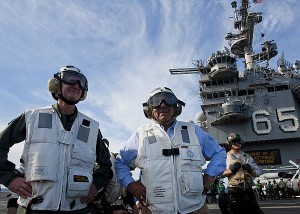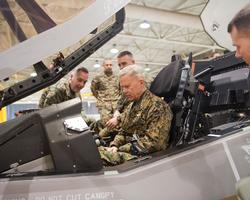01/26/12 by Ed Timperlake
Since the term “Tailhook” entered the vernacular (as a rowdy out of control party because of a social engineering agenda that set that media template), American’s may have lost sight that a real tail hook is a deadly serious piece of equipment.
It was said during the height of Carrier Battle Groups launched “Alpha Strikes,” as many aircraft as possible, from Yankee Station off the coast of Vietnam, Naval Aviators experienced several stress inducing moments.
The dodging of surface to air missiles, flack from anti-aircraft batteries and going into air-to-air “dog fights” against peer competitors were what current psyco-babble arm chair shrinks would call “stressors.”
One of the surprising findings, which is only a news flash for those who have never done it, was the significant stress of getting back on board the Carrier after the mission. A night recovery in marginal weather in a significant sea state off Vietnam was a higher “stresser” then going downtown Hanoi, and that was really saying something.

“That afternoon there was a brief for an Alfa strike into downtown Dodge [Hanoi]. The ever-smiling intel officer reported there were 1,600 surface-to-air missile sites five miles from the target with 40,000 guns and 1,500 MiGs. The weather was perfect — they will see you coming for 500 miles.”
Boom Powell “From the Cat Walk” Tailhook Association.
Becoming a carrier qualified Naval Aviator is a zero defect unforgiving learning process-qualify at the boat or you are gone. Flying operationally in the fleet is also unforgiving because one mistake and often the aircrew and others on the Carrier deck will be killed. So when analysis showed the F-35C needed engineering fix to safely trap it is a big deal that will be fixed. The Navy has been there and done that.
The magnificent World War II Corsair, the F-4U was not only called “whistling death” but it was also referred to as the “Hose Nose”. Because of a very large powerful engine, significantly huge propellers and “gull wing” design it had trouble getting aboard Carriers.
Taken from the history of the F-4U:
“Carrier suitability was a major development issue, prompting changes to the main landing gear, tail wheel and tailhook. …Problems were encountered during early carrier trials. The combination of an aft cockpit and the Corsair’s long nose made landings hazardous for newly trained pilots
The US Navy received its first production F4U-1 on 31 July 1942, but getting it into service proved difficult. The framed “birdcage” style canopy provided inadequate visibility for deck taxiing. Even more seriously, the machine had a nasty tendency to “bounce” on touchdown, which could cause it to miss the arresting hook and slam into the crash barrier, or even go out of control. The long “hose nose” visibility problem and the enormous torque of the Double Wasp engine also created operational problems.
Carrier qualification trials on the escort carrier USS Sangamon on 25 September 1942, caused the U.S. Navy to release the type to the United States Marine Corps. Early Navy pilots spoke disparagingly of the F4U as the “hog”, “hosenose” or “bent wing widow-maker.”
Taking full advantage of being given a superior fighter in the Solomon’s Campaign, Marine pilots like Pappy Boyington CMH and his squadron VMF-214,The Black Sheep, along with fellow Marines flying with VMF-323, Death Rattlers, and other squadrons later in the war, VMF-321 Hells Angles, all made aviation combat history.
The Navy eventually fixed the F-4U problems and it became a welcome addition to USN squadrons aboard Pacific Carrier Task Forces taking the fight across the Pacific to Japan.
Fast-forward to the jet age of Carrier aviation and a little known inside Navy air fact must be discussed. The RA-5 Vigalente was an extremely difficult aircraft to safely bring back to the ship; again it was a tail hook issue.
Once a tail hook even separated from the “Viggie” returning from a combat mission.
But every landing was a challenge requiring great skill.
The RA-5 had a high landing speed angle of attack and a tail hook design that if it slapped back into the airframe it could cause “Alpha” damage. To translate a bad approach and landing and the pilot might destroy the aircraft—“”Alpha Class Mishap.”
In those days it was known that the RA-5 Vigilante pilots were the most skilled aviators in landing aboard the boat.
In the highly competitive world of Naval Aviation, the RA-5 pilots took a design issue –the tail hook-and with great skill carried on.
However, the real lesson is that any flaw with the “hook” must be addressed so all “nuggets,” first tour aviators, can bring their aircraft safely. So finding and fixing a tail hook problem with the F-35C is a very good thing.
But what to do about possible combat needs and operations during the delay of the F-35C? Easy in this Centennial Year of Marine Aviation the answer is simple: surge the F-35B. The “B” is the USMC, and Italian V/STOL version that just had an excellent at sea test cycle getting aboard the USS Wasp.
https://www.sldinfo.com/naval-aviation-the-next-100-years/
Secretary Panetta and Commandant Amos recognize the value of the F-35B, and Secretary Panetta has just put special trust and confidence in Marine aviation-
“U.S. Defense Secretary Leon Panetta has taken the Marine Corps’ prized F-35B short takeoff vertical landing version of the Joint Strike Fighter off “probation,” the top Pentagon leader told a crowd of Navy testers.”
“A senior Defense official added that the capabilities of the B-model had particularly impressed the secretary. The AV-8B Harrier, which similar offers similar STOVL capabilities has proven useful fighting terrorists in the Middle East, he said.
Panetta said that aircraft, like the F-35, represents the type of advanced technology a smaller U.S. military will need.”

And General Amos, the first USMC Commandant to wear Navy Wings of Gold nails it perfectly:
The F-35B represents the Marine Corps’ ongoing effort to modernize our aging fleet of aircraft and to take advantage of 5th generation technology that will greatly enhance our capabilities as America’s expeditionary crisis response force.
Our nation’s shipbuilding and sustainment plan calls for 22 capital ships (11 carriers and 11 large deck amphibious warships) capable of deploying fixed-wing tactical strike aircraft. Full fielding of the F-35B will ensure our nation preserves this important deterrent and response capability as the STOVL F-35B is the only model capable of operating off of our large deck amphibious warships, and in austere and remote expeditionary land-based operating environments.
For decades our nation has benefitted from the STOVL capability that is now resident in the F-35B. From Operation Desert Storm to today’s present conflict in Afghanistan, STOVL technology has enabled tactical fixed-wing aviation to operate from expeditionary locations ashore and afloat in close proximity to ground forces. The responsive and persistent intelligence, surveillance, reconnaissance and strike capabilities have saved lives and provided operational commanders with a tremendous tactical advantage.
So like the historically distant Solomon’s campaign when the Navy had “The Big E” USS Enterprise and the 1st Marine Division fighting to keep Henderson Field open for the F-4U. The Navy Marine aviation team historically has taken turns coming to each other’s assistance to fight and win.
That tradition will continue with the introduction of the F-35 B&C model into the fleet.
https://www.sldinfo.com/winning-the-airsea-battle/
https://www.sldinfo.com/bold-alligator-2012-in-historical-perspective/
Featured Image: USMC F-35B Lands at Eglin AFB January 2012 Credit: 33rd Fighter Wing
Editor’s Note: Ed Timperlake was CO of VMFA-321 when the squadron had extremely skilled Marine Pilots flying the wonderful next USN/USMC F-4-The F-4 Phantom II.

